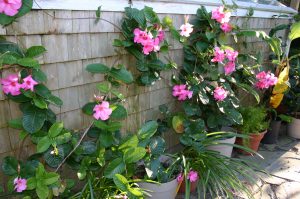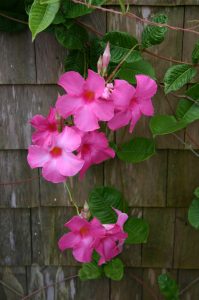
Mandevilla, with their numerous, large, brilliantly colored flowers, are highly prized for the tropical look they give to summertime decks and patios. Knowing that these plants originate from South America, mostly Brazil, gives a clue to the conditions they prefer – warm temperatures and plenty of sunshine. In general, mandevilla need at least six or seven hours of sunlight daily to stay in flower, with daytime temperatures over 55°F. Below 45-50°F, these highly frost-sensitive perennials won’t flower, and frost will kill them. That means that here in New England mandevilla must be brought indoors for winter. This must always be done before the first frost arrives.
With their rapid, vining growth habit, these plants can become very large, making a relatively tall greenhouse a perfect place for them to spend the winter months. Don’t be concerned if your winter greenhouse lacks sufficient light and heat to keep these beautiful plants in bloom. As long as you can maintain a minimum temperature of 50°F, you can keep mandevilla in a state of waiting, ready to flower profusely again come spring.

Knowing the other conditions that mandevilla prefer will help them remain healthy during their stay in your winter greenhouse. Mandevillas like neutral to slightly acidic soil, with ample organic matter and good drainage. A potting mix with some sand and leaf mold or compost added should do the job. Keep the soil slightly moist but not overwatered. These plants won’t tolerate soil that’s persistently either dried-out or waterlogged. In these adverse soil conditions, the leaves may turn brown and drop off. Correct fertilization is also important. About a month before moving these plants back outdoors, feed them with a basic fertilizer (10-10-10) to encourage strong growth and lots of flowers. To enhance blooming especially, use a fertilizer that contains more phosphorus than nitrogen (5-10-10).

You should know as well how to best prune your mandevilla. These vines can grow very tall, up to fifteen feet, in the right conditions. Even with a trellis or pillar on which to climb, mandevilla can easily get out of control. Come spring in my greenhouse I often find that they’ve entwined themselves around other plants, requiring that they be unwound and/or trimmed before being moved outdoors. When pruning mandevilla, it’s best to never cut off more than 25% of the plant. You can also keep the growth habit significantly more compact by pinching off four to six inches of the leaders as they grow. The plant will become bushier and, in my opinion, more attractive
The cut-off tips from mandevilla can be used to propagate new plants. Take a tip with two leaves on it, dip the base in rooting hormone, and plant it in sandy potting soil. The soil must be kept fairly moist in an area where the temperature stays at or above 65-70°F. It may take about three weeks to a month for the cuttings to root firmly. But with patience, you’ll soon have small plants ready to be put in containers for rapid summer growth. In my view, it’s hard to have too many of these magnificent, summer-long flowers.


